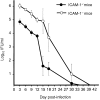The intercellular adhesion molecule type-1 is required for rapid activation of T helper type 1 lymphocytes that control early acute phase of genital chlamydial infection in mice
- PMID: 10594682
- PMCID: PMC2326957
- DOI: 10.1046/j.1365-2567.1999.00926.x
The intercellular adhesion molecule type-1 is required for rapid activation of T helper type 1 lymphocytes that control early acute phase of genital chlamydial infection in mice
Abstract
Recent studies in animal models of genital chlamydial disease revealed that early recruitment of dendritic cells and specific T helper type-1 (Th1) cells into the genital mucosae is crucial for reducing the severity of the acute phase of a cervico-vaginal infection and arresting ascending disease. These immune effectors are therefore important for preventing major complications of genital chlamydial infection. Other in vitro studies showed that intercellular adhesion molecule-1 (ICAM-1) plays a role in the antichlamydial action of specific CD4+ and CD8+ T cells. In the present study, we investigated the clinicopathological consequences of ICAM-1 deficiency during chlamydial genital infection in ICAM-1 knockout (ICAM-1KO) mice, and analysed the cellular and molecular immunological bases for any observed pathology or complication. Following a primary genital infection of female ICAM-l-/- and ICAM-1+/+ mice, the intensity of the disease during the first 3 weeks (as assessed by shedding of chlamydiae in the genital tract) was significantly greater in ICAM-1KO mice than in ICAM-1+/+ mice (P < 0.0001), although both ICAM-l-/- and ICAM-1+/+ mice subsequently cleared the primary infection. There was greater ascending disease during the initial stage of the infection, and a higher incidence of tubal disease (hydrosalpinx formation) after multiple infections in ICAM-l-/- mice. Analysis of the cellular and molecular bases for the increased acute and ascending disease in ICAM-l-/- mice revealed that the high affinity of ICAM-1 for leucocyte function antigen type-1 is a property that promotes rapid activation of specific Th1 cells, as well as their early recruitment into the genital mucosa. Moreover, ICAM-1 was more important for naive T-cell activation than primed Th1 cells, although its absence delayed or suppressed immune T-cell activation by at least 50%. Taken together, these results indicated that ICAM-1 is crucial for rapid T-cell activation, early recruitment and control of genitally acquired Chlamydia trachomatis.
Figures






References
-
- WHO (World Health Organization) Global Prevalence and Incidence of Selected Curable Sexually Transmitted Diseases: Overview and Estimates. Geneva: WHO; 1996.
-
- Schachter J, Grayston JT. Epidemiology of human chlamydial infections. In: Stephens RS, Byrne GI, Christiansen, G, et al., editors. Chlamydial Infections. San Franciso, CA: ICS; p. 3.
-
- D.C. & P.H.S Chlamydia trachomatis Genital Infections – United States, 1995. Morbidity Mortality Weekly Report. 1997;46:193. - PubMed
-
- Paavonen J, Wolner‐hanssen P. Chlamydia trachomatis: a major threat to reproduction. Hum Reprod. 1989;4:111. - PubMed
-
- Scholes D, Stergachis A, Heidrich FE, Andrilla H, Holmes KK, Stamm WE. Prevention of pelvic inflammatory disease by screening for cervical chlamydial infection. N Engl J Med. 1996;334:1362. - PubMed
Publication types
MeSH terms
Substances
Grants and funding
LinkOut - more resources
Full Text Sources
Other Literature Sources
Medical
Molecular Biology Databases
Research Materials
Miscellaneous

